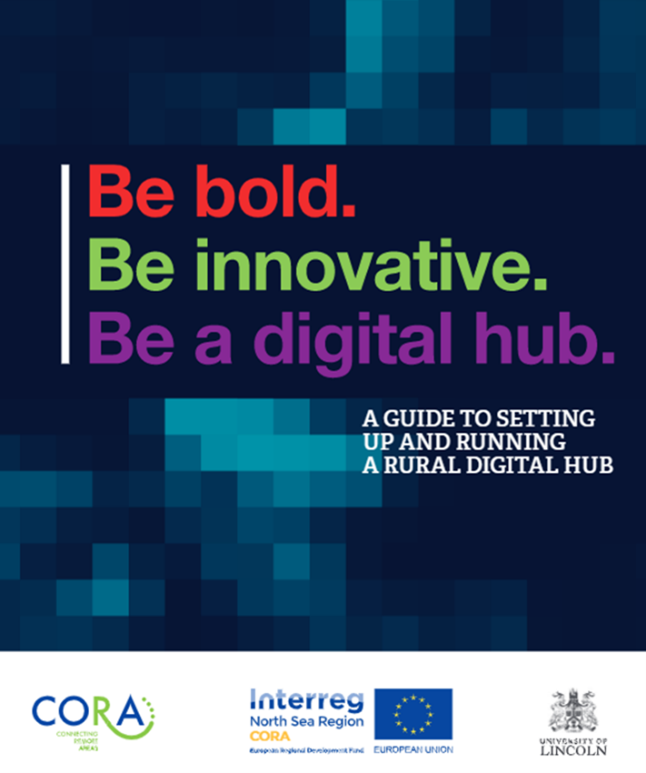Creating Sustainable Digital Hubs in Rural Areas

It is estimated that in the UK 12% of rural homes do not currently have access to superfast broadband and 11 million (21%) people are without the digital skills needed for everyday life. Researchers from Lincoln International Business School have been finding ways to help reduce these digital divides using Digital Hubs – physical spaces with access to superfast broadband alongside community and business focussed services.
Why do we need digital hubs?
The presence of a fast and reliable broadband network is of crucial importance to the economic and social development of an area. It is key to business competitiveness and social inclusion, providing access to a range of emerging technologies linked to business, public sector services, health and education. The Fourth Industrial Revolution is offering opportunities to transform the way we live and work, by providing a range of technological developments that have the potential to fundamentally change society, much in the same way that electricity and automation did during previous industrial revolutions. However, there are still many reasons why people are not digitally connected, including a lack of access to digital devices, poor digital skills, affordability or simply a choice to stay unconnected. These issues are often magnified in rural areas where digital connectivity and internet services are poorest, thus reinforcing the urban–rural digital divide. Without policy intervention, there is a risk that rural ‘hard to reach’ communities and economies will continue to be left behind as residents are unable to access superfast digital networks or lack the skills to use them.

Why do we need more research on setting up digital hubs?
Digital hubs are one solution that policymakers can implement in rural regions to promote digital engagement among communities and businesses. In their guide, Be Bold; Be Innovative; Be a Digital Hub, Price and Deville from the Lincoln International Business School set out how digital hubs can be used to improve access to, and the use of, internet-enabled technology in rural areas therefore helping to enhance the local digital environment and tackle digital competency gaps.
The guide has been used both in the UK and Europe by policy makers setting up digital hubs. However, during this work gaps in knowledge around assessing demand for a hub, identifying an optimum mix of services, obtaining start-up funding and becoming financially sustainable was identified. Researchers therefore spoke to the managers of digital hubs in the UK, Ireland, Netherlands, Denmark and Belgium to try and fill these gaps in knowledge. These hubs ranged from co-working spaces simply offering desk or office space to high tech Fablabs based within academic institutions. Interviews covered how hubs obtained their start-up funding, how they generated and retained users as well as how they had become financially sustainable
What did the research find?
The results showed that despite differences in the location and scale of the digital hubs they were often facing the same challenges. Key messages were focussed around 4 key themes:
Initiating the hub
- There are many different models for start up funding
- Start small and grow the hub alongside its user community
- Consider membership/subscription to promote buy in and sustain incomegeneration
“Going back to the start now, I wouldn’t have bought all that other equipment. I think I kind of felt that we had to buy it almost to validate ourselves… I thought I needed to have all that stuff to give us sort of credibility”
TechCreate, Ireland
Developing the hub future
- Have a committed, passionate leader to advocate for the hub
- Consider co-location/service aggregation to help attract and maintain a user base
- Ensure you have skilled staff
“We actually placed the hub close to the library and at this public culture house. So there was already a known location and people…. And you know, we could just add to the local offerings.”
Vejle Library, Denmark
The hub as a community
- Build a community around the hub and co-design services with them
- Link to other hubs for support and knowledge exchange
- Empower users to use the technology, don’t do it for them!
“What to us is a really important is the atmosphere and sense of community and making it easy for people to find out who everyone else is. So we just have little Polaroid pictures … on the wall with ….13 or 15 words to describe what they do, and that’s all. And they’re all up there together”
The Impact Hub, UK
Marketing the hub for sustainability
- Ensure there is a realistic plan
- Use promotion around events
- Market persistently to remind people the hub exists….
- …but don’t underestimate the power of word of mouth
“ The first couple of years were very much like, you know, pushing the boulder up a hill and then, you know, once it gets to the top and starts getting a lot of traction itself it just kind of grows then”
Saxion Fablab, Netherlands
How will the research be used?
This research with hub managers has created an evidence base which can be used to develop support and help for policy makers wishing to open rural digital hubs in their area. The findings have already been shared with policy makers in a number of local authorities looking at setting up digital hubs and used to develop an online learning guide Rural Digital Hubs – Ensuring Buy-In and Engagement. It is hoped that this will offer guidance on how to find out what will work best in their locality and how they may fund the provision.

More information:
To find out more please visit on the COnnecting Remote Areas project website.
